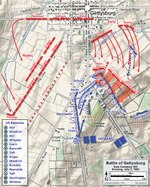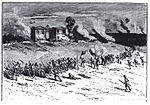East Cemetery Hill
Cemetery HillHills of PennsylvaniaLandforms of Adams County, Pennsylvania

East Cemetery Hill is a Gettysburg Battlefield landform used for the battle of East Cemetery Hill during the 1863 Battle of Gettysburg, Second Day. Located on the east of Gettysburg's Baltimore Street and the Baltimore Pike which meet on the hill, the hill is a northeast spur, and the east slope, of Cemetery Hill. The hill has numerous postbellum battlefield monuments, as well as artillery lunettes remaining from the Battle of Gettysburg. Slocum Avenue is on the south slope, while Wainwright Avenue is near the east base.
Excerpt from the Wikipedia article East Cemetery Hill (License: CC BY-SA 3.0, Authors, Images).East Cemetery Hill
Baltimore Street,
Geographical coordinates (GPS) Address Nearby Places Show on map
Geographical coordinates (GPS)
| Latitude | Longitude |
|---|---|
| N 39.822 ° | E -77.229 ° |
Address
1st NY Light Artillery Battery I “Wiedrich’s Battery” Wiedrich
Baltimore Street
17325
Pennsylvania, United States
Open on Google Maps











